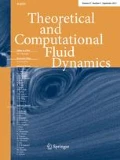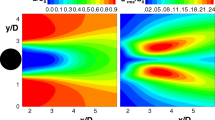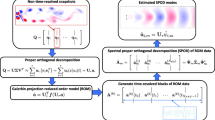Abstract
Geometries containing a narrow gap are characterized by strong quasi-periodical flow oscillations in the narrow gap region. The above mentioned phenomena are of inherently unstable nature and, even if no conclusive theoretical study on the subject has been published, the evidence shown to this point suggests that the oscillations are connected to interactions between eddy structures of turbulent flows on opposite sides of the gap. These coherent structures travel in the direction of homogeneous turbulence, in a fashion that strongly recalls a vortex street. Analogous behaviours have been observed for arrays of arbitrarily shaped channels, within certain range of the geometric parameters. A modelling for these phenomena is at least problematic to achieve since they are turbulence driven. This work aims to address the use of Proper Orthogonal Decomposition (POD) to reduce the Navier–Stokes equations to a set of ordinary differential equations and better understand the dynamics underlying these oscillations. Both experimental and numerical data are used to carry out the POD.
Similar content being viewed by others
Abbreviations
- y + :
-
Normalized wall distance
- x i :
-
Cartesian coordinates (vector notation)
- x, y, z :
-
Cartesian coordinates
- u :
-
Velocity vector
- u i :
-
Cartesian velocity components
- u :
-
Cartesian velocity component in direction x
- v :
-
Cartesian velocity component in direction y
- w :
-
Cartesian velocity component in direction z
- w bulk :
-
Bulk velocity
- \({\langle f \rangle}\) :
-
Ensemble averaging operator on function f
- f′:
-
Fluctuation over the ensemble average \({f=f-\langle f \rangle}\)
- ρ :
-
Density
- υ :
-
Kinematic viscosity
- Δ:
-
Filter width, mesh size
- u τ :
-
Friction velocity
- λ:
-
Wavelength of the coherent structures
- D h :
-
Hydraulic diameter
- Re :
-
Bulk Reynolds number Re = D h w bulk/ν
- g :
-
Inner to outer diameter
- e :
-
Eccentricity e = d/D h
- d :
-
Distance between the cylinder axis for the eccentric channel
- f :
-
Frequency
- T :
-
Period
- k :
-
Wavenumber
- m :
-
Quantum number
- L :
-
Length of the domain in the streamwise direction
- a i :
-
Coefficients of the POD modes
- S ij :
-
Strain tensor
- τ ij :
-
SGS stress tensor
- M :
-
Number of snapshots
- N eq :
-
Number of modes used in the ODE set
- M eq :
-
Number of oscillatory modes contained in the ODE set
References
Hooper J.D., Rehme K.: Large-scale structural effect in developed turbulent flows through closely-spaced rod arrays. J. Fluid Mech. 145, 305–337 (1984)
Meyer L., Rehme K.: Large-scale turbulence phenomena in compound rectangular channels. Exp. Therm. Fluid Sci. 8, 286–304 (1994)
Merzari E., Ninokata H., Baglietto E.: numerical simulation of the flow in tight-lattice fuel bundles. Nucl. Eng. Des. 238, 1703 (2008)
Merzari E., Wang S., Ninokata H., Theofilis V.: Biglobal linear stability analysis for the flow in eccentric annular channels and a related geometry. Phys. Fluids 20, 114104 (2008). doi:10.1063/1.3005864
Gosset A., Tavoularis S.: Laminar flow instability in a rectangular channel with a cylindrical core. Phys. Fluids 18, 044108 (2006)
Guellouz M.S., Tavoularis S.: The structure of turbulent flow in a rectangular channel containing a cylindrical rod—Part I: Reynolds averaged experiments. Exp. Therm. Fluid Sci. 23, 59 (2000)
Lexmond, A., Mudde, M., Van der Haagen M.: Visualization of the vortex street and characterization of the cross flow in the gap between two subchannels. In: Proceedings of 11th Nureth. Avignone, Paper 122 (2005)
Aubry N., Holmes P., Lumley J.L., Stone E.: The dynamics of coherent structures in the wall region of a turbulent boundary layer. J. Fluid Mech. 192, 115–173 (1988)
Sanghi S., Aubry N.: Low dimensional models for the structure and dynamics in near wall turbulence. J. Fluid Mech. 247, 455–488 (1993)
Lumley J.L.: Stochastic Tools in Turbulence. Academic Press, New York (1970)
Berkooz G., Holmes P., Lumley J.L.: The proper orthogonal decomposition in the analisys of turbulent flow. Ann. Rev. Fluid Mech. 25, 539–575 (1993)
Sirovich L.: Turbulence and the dynamics of coherent structures, Part I: Coherent structures. Q. Appl. Math. XLV, 561–571 (1987)
Aubry N., Guyonnet R., Lima R.: Spatiotemporal analysis of complex signals: theory and applications. J. Stat. Phys. 64, 683–739 (1991)
Merzari E., Ninokata H.: Anisotropic turbulence and coherent structures in eccentric annular channels. Flow Turbul. Combust. 82, 93–120 (2009). doi:10.1007/s10494-008-9170-2
Deardorff J.W.: A numerical study of three-dimensional turbulent channel flow at large Reynolds numbers. J. Fluid Mech. 41, 453–480 (1970)
Aubry N.: On the hidden beauty of the proper orthogonal decomposition. Theor. Comput. Fluid Dyn. 2, 339–352 (1991)
Aubry N., Guyonnet R., Lima R.: Spatio-temporal symmetries and bifurcations via bi-orthogonal decompositions. J. Nonlinear Sci. 2, 183–215 (1992)
Zang Y., Street R.L., Koseff J.R.: A non-staggered grid, fractional step method for time-dependent incompressible Navier–Stokes equations in curvilinear coordinates. J. Comput. Phys. 114, 1 (1994)
Jordan S.A.: Dynamic subgrid-scale modeling for large-eddy simulations in complex topologies. J. Fluids Eng. 123(3), 619–627 (2001)
Kasagi, N., Horiuti, K., Miyake, Y., Miyauchi, T., Nagano, Y.: Establishment of the direct numerical simulation data bases of turbulent transport phenomena. Available on the Website of Tokyo University. http://www.thtlab.t.u-tokyo.ac.jp/
Nikitin N.V.: Direct numerical simulation of turbulent flows in eccentric pipes. Comput. Math. Math. Phys. 46, 509–526 (2006)
Omurtag A., Sirovich L.: On low-dimensional modeling of channel turbulence. Theor. Comput. Fluid Dyn. 13, 115–127 (1999)
Merzari, E., Ninokata, H.: Toward a dynamical system approach for the understanding of turbulent flow pulsation between subchannels. In: Proceedings of the 12th Nureth. Pittsburgh, USA (2007)
Cazemier, W.: Proper orthogonal decomposition and low dimensional models for turbulent flow. PhD thesis, University of Groningen, Groningen, The Netherlands (1997). ISBN 90-367-0682-3
Shampine L.F., Reichelt M.W.: The MATLAB ODE suite. SIAM J. Sci. Comput. 18, 1–22 (1997)
Author information
Authors and Affiliations
Corresponding author
Rights and permissions
About this article
Cite this article
Merzari, E., Ninokata, H., Mahmood, A. et al. Proper orthogonal decomposition of the flow in geometries containing a narrow gap. Theor. Comput. Fluid Dyn. 23, 333–351 (2009). https://doi.org/10.1007/s00162-009-0152-3
Received:
Accepted:
Published:
Issue Date:
DOI: https://doi.org/10.1007/s00162-009-0152-3




